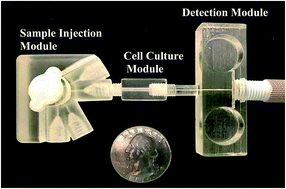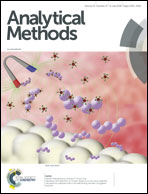Use of 3D printing and modular microfluidics to integrate cell culture, injections and electrochemical analysis†
Abstract
Fabrication of microchip-based devices using 3D printing technology offers a unique platform to create separate modules that can be put together when desired for analysis. A 3D printed module approach offers various advantages such as file sharing and the ability to easily replace, customize, and modify the individual modules. Here, we describe the use of a modular approach to electrochemically detect the ATP-mediated release of nitric oxide (NO) from endothelial cells. Nitric oxide plays a significant role in the vasodilation process; however, detection of NO is challenging due to its short half-life. To enable this analysis, we use three distinct 3D printed modules: cell culture, sample injection and detection modules. The detection module follows a pillar-based wall-jet electrode design, where the analyte impinges normal to the electrode surface, offering enhanced sensitivity for the analyte. To further enhance the sensitivity and selectivity for NO detection the working electrode (100 μm gold) is modified by the addition of a 27 μm gold pillar and platinum-black coated with Nafion. The use of the pillar electrode leads to three-dimensional structure protruding into the channel enhancing the sensitivity by 12.4 times in comparison to the flat electrode (resulting LOD for NO = 210 nM). The next module, the 3D printed sample injection module, follows a simple 4-port injection rotor design made of two separate components that when assembled can introduce a specific volume of analyte. This module not only serves as a cheaper alternative to the commercially available 4-port injection valves, but also demonstrates the ability of volume customization and reduced dead-volume issues with the use of capillary-free connections. Comparison between the 3D printed and a commercial 4-port injection valve showed similar sensitivities and reproducibility for NO analysis. Lastly, the cell culture module contains electrospun polystyrene fibers with immobilized endothelial cells, resulting in 3D scaffold for cell culture. With the incorporation of all 3 modules, we can make reproducible ATP injections (via the 3-D printed sample injection module) that can stimulate NO release from endothelial cells cultured on a fibrous insert in the cell culture module which can then be quantitated by the pillar WJE module (0.19 ± 0.03 nM per cell, n = 27, 3 inserts analyzed each day, on 9 different days). The modular approach demonstrates the facile creation of custom and modifiable fluidic components that can be assembled as needed.

- This article is part of the themed collection: Microfluidic systems with societal impact


 Please wait while we load your content...
Please wait while we load your content...